Marathon Gold Showcases Valentine Exploration Potential at 2023 PDAC

Multiple Areas of Gold Mineralization on 32km-long Trend
Figure 1

Figure 2

Figure 3
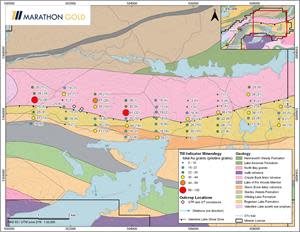
Figure 4

Figure 5

Figure 6

Figure 7
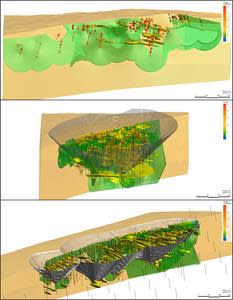
TORONTO, March 06, 2023 (GLOBE NEWSWIRE) -- Marathon Gold Corporation (“Marathon” or the “Company”; TSX: MOZ) will be showcasing the exploration potential of the Company’s 100% owned Valentine Gold Project at the 2023 Prospector’s and Developer’s Association of Canada (“PDAC”) convention in Toronto between March 5-8. Marathon’s Newfoundland & Labrador based exploration team, led by Dave Ross, VP Geology and Exploration, will be available at booth # 2241. Matt Manson, President & CEO, will be presenting on Tuesday March 7 at 9:10am at the Atlantic Edge symposium and on Tuesday March 7 at 2:14pm in the Investors Exchange.
The Valentine Gold Project is under construction, and when complete will be the largest gold mine in Atlantic Canada. An Updated Feasibility Study released in December, 2022 described a 3 pit-mine plan delivering 195,000 oz Au per annum at an AISC of US$1,007 per oz for the first 12 years of a 14.3 year mine life. Proven and Probable Mineral Reserves are 2.7 Moz Au (51.6 Mt at 1.62 g/t Au), with first gold scheduled for the first quarter of 2025.
Marathon’s exploration priorities for the Project during construction are: (1) delivering more ounces of mineable gold mineralization within the scope of the existing 3-pit mine plan, and (2) making new discoveries leading to new Mineral Resources elsewhere on the Valentine property outside the scope of the current mine plan. 2022 diamond drilling at the Berry Deposit, and a 70,000 metre Reverse Circulation drill program at the Leprechaun and Marathon Deposits during 2023 and 2024, will support the former objective. At PDAC, Marathon will be showcasing opportunities for new Mineral Resources and discovery. These include:
Latest exploration results at Eastern Arm and Western Peninsula prospecting areas, showing gold geochemical anomalies including significant counts of gold grains in till samples following the 2022 discovery of QTP mineralization in bedrock and float;
Latest drill results at Victory Deposit, including 3.50 g/t Au over 9.6m (VGD-22-098), 2.11 g/t Au over 15m (VGD-22-101), and 0.93 g/t Au over 13m (VGD-22-100); and
A fresh look at the Frank Zone: discovered in 2011, but with the same geological characteristics as the nearby Berry and Leprechaun Deposits. Historical drill results include 12.52 g/t Au over 2.9m (VL-12-490), 10.87 g/t Au over 3m (VL-12-500), and 2.03 g/t Au over 16m (VL-12-455).
Matt Manson, President and CEO, commented: “As we focus on the construction of the Valentine Gold Project and the delivery of first gold from the Leprechaun, Berry and Marathon Deposits, our exploration team has been stepping out to focus on the future discovery potential at the property. As previously reported, we see quartz-tourmaline-pyrite veining in the characteristic Valentine style in multiple locations over the full 32-kilometre geological trend at the property. For reference, this is equivalent to the scale of the entire Timmins-Porcupine gold camp in Ontario, which hosts multiple individual gold mines. Today’s news release summarizes this discovery potential and includes for the first time exciting new gold grain data from the “Eastern Arm” prospecting area. We invite interested parties to visit with our Newfoundland and Labrador exploration team this week at the 2023 PDAC in Toronto to hear more about our current and future plans for exploration success at Valentine.”
Gold Mineralization at the Valentine Gold Project
Gold mineralization at the Valentine Gold Project is contained in Quartz-Tourmaline-Pyrite-Gold (“QTP-Au”) veins developed within granitoid rocks of the Valentine Lake Intrusive Suite (“VLIS”) on the hanging wall, or northwest, side of the Valentine Lake Shear Zone (“VLSZ”; Figure 1). Up to four orientations of veins have been measured, with shallowly southwest dipping “Set 1” QTP-Au veins observed to be dominant in both abundance and gold content. At the Leprechaun, Marathon and Berry Deposits, Set 1 QTP-Au veins form densely stacked corridors of mineralization referred to as “Main Zones”. The extent and scale of these mineralized corridors appear related to the size and frequency of sheared mafic dykes which extend northeast-southwest within the granitoid rocks, approximately parallel to the shear zone.
Mineral Resources have been estimated at the Leprechaun, Berry and Marathon Deposits, which are the focus of current mine planning, in addition to the smaller Sprite and Victory Deposits. The Project’s total Measured and Indicated Mineral Resources (inclusive of the Mineral Reserves) are 3.96 Moz (64.62 Mt at 1.90 g/t). Additional Inferred Mineral Resources are 1.10 Moz (20.75 Mt at 1.65 g/t Au).
Figure 1: Location Map Showing Exploration Targets and Mineral Deposits, Valentine Gold Project
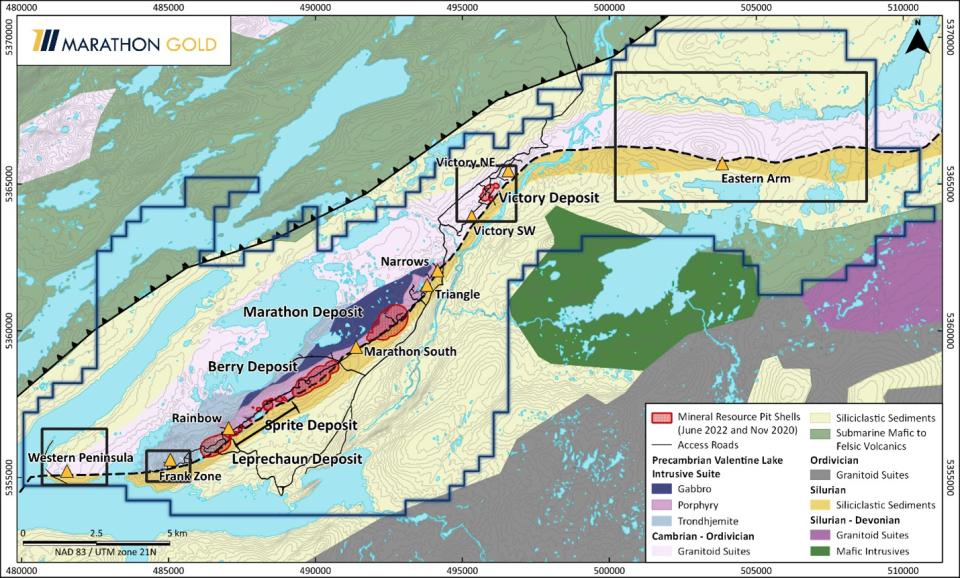
Eastern Arm and Western Peninsula Prospecting Areas
During 2022, reconnaissance mapping and prospecting in the Eastern Arm area demonstrated rocks of a similar nature to the VLIS continuing eastwards in contact with the Rogerson Lake Conglomerate along the VLSZ, the same geological relationship that hosts most known gold mineralization at Valentine (Figure 1). In total, granitoid intrusive rocks are interpreted to continue for an additional 13 kilometers to the eastern most property boundary.
During the 2022 program, bedrock and float occurrences of QTP veining were observed in granitoid host rocks at several locations (Figure 2). Sixty 12 kilogram till samples were taken over an 8-kilometer interval of the VLSZ contact, from 10 cm to 90 cm deep hand-dug pits. Results from this program have now been received. Multiple samples returned significant counts of pristine gold grains, indicative of a nearby bedrock source (Figure 3).
Figure 2: Field Occurrences of QTP veining in the Eastern Arm Area, Valentine Gold Project. Left: granitoid outcrop with up to seven 0.5-3 cm Quartz-Tourmaline veins in stacked configuration. Middle: Classic Valentine extensional Quartz-Tourmaline-Pyrite vein in outcrop. Right: coarse pyrite in Quartz-Tourmaline-Pyrite vein float sample.

Figure 3: Gold Grains in till samples, 2022 sampling, Eastern Arm Prospecting Area, Valentine Gold Project.
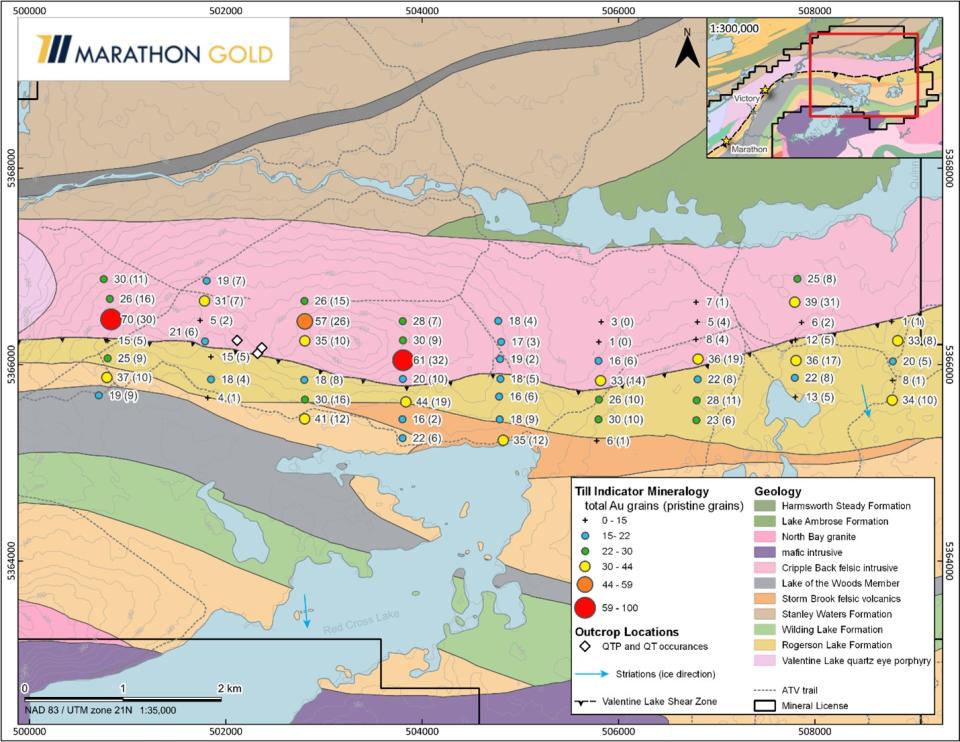
Extending the sampling grid in the Eastern Arm, conducting infill sampling, and collecting additional drift prospecting data will assist to tighten up targeting for future work. However, the grain counts observed at the Eastern Arm, their coincidence with bedrock QTP occurrences, and the close proximity of the VLSZ through the area makes the Eastern Arm a key priority for future exploration. Marathon’s 2023 summer program will focus on prospecting and trenching and identifying targets for a future potential drill program. As a reminder, three million ounce-plus mineral deposits have to date been delineated over an approximately 6-kilometre interval in the western portion of the Valentine property. The Eastern Arm area is 13 kilometres in strike extent, with reconnaissance scale sampling over only 8 kilometres.
At the end of the 2022 prospecting season, a brief reconnaissance mapping and sampling program was undertaken at the Western Peninsula prospecting area. This is a 2-kilometre interval of VLIS rocks in contact with the Rogerson Lake Conglomerate at the VLSZ, at the westernmost extent of the property (Figure 1). As at the Eastern Arm area, QTP veining was observed in bedrock and float samples. A small number of soil samples were collected and processed for gold content. Targeting the B-horizon, soil samples were collected by auger and placed in paper craft bags with a corresponding sample tag. If B-horizon was unavailable, C-horizon (till) was collected. Gold anomalies proximal to the VLSZ were again observed (Figure 4). Completion of the sampling program has been scheduled for the 2023 exploration program.
Figure 4: Gold geochemical anomalies in soil samples, 2022 sampling, Western Peninsula Prospecting Area, Valentine Gold Project.
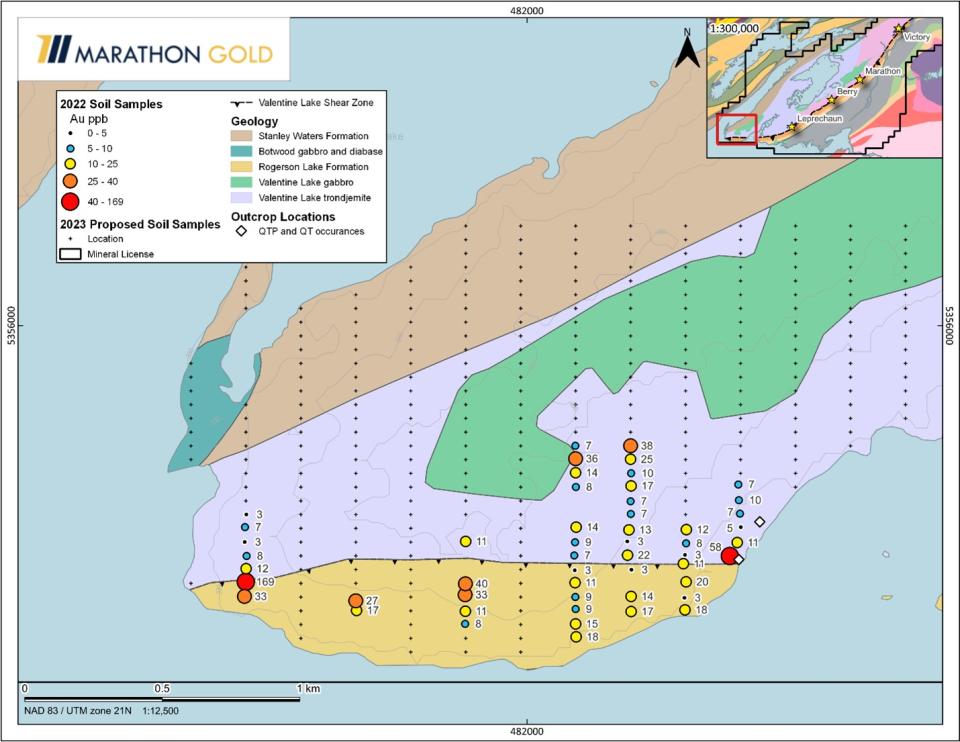
Victory Deposit
In total, twenty-one drill holes were completed at the Victory Deposit in 2022 (Figure 4). Results from three were reported previously (Marathon news releases dated June 15, 2022). The remaining eighteen are reported here. The 2021 and 2022 drilling at Victory, the first since 2014, was focussed to the south and southwest of the area of historical drilling and the existing mineral resources (Figure 4). The objective was to test for a Main Zone type configuration of gold mineralization adjacent to the VLSZ, as seen at the Leprechaun and Berry Deposits. All of the new holes were located within hanging-wall Precambrian granitoid rocks. Two holes were abandoned for technical reasons. Of the remaining 19 holes, all but three were oriented to the southeast to define the younger Rogerson Lake Conglomerate at the shear zone contact.
Fifteen of the drill holes reported today returned “significant” drill intercepts of greater than 0.7 g/t Au (Table 1). Mineralization at the Victory Deposit is often characterized by long intercepts of typically lower grade, tourmaline-rich stockworks in addition to the discrete but higher grade QTP veins characteristic of the other deposits. This is reflected in a greater proportion of drill core samples with gold grades of between 0.1 g/t Au and 0.3 g/t Au than is seen at Berry, Leprechaun or Marathon. This is illustrated in Figure 5, which shows gold grades at both a 0.3 g/t Au cut-off, the bottom cut-off used in the July 2022 Mineral Resource Estimate for the Project (top) and at 0.1 g/t Au (bottom).
The Victory Deposit area is significant for two reasons: (1) it represents the potential for additional open pit mill feed to the Project’s life-of-mine plan as a satellite deposit, and (2) possibly more significant, it is a direct indication of significant volumes of gold mineralizing fluids in the northeast quadrant of the Valentine property, improving our understanding of the gold mineralization dynamics along the VLSZ as we push our exploration focus into the under-explored and extensive Eastern Arm prospecting area.
Figure 5: Location of Victory Deposit Exploration Drill Hole Collars VGD-22-088, and VGD-22-90 to VGD-22-104
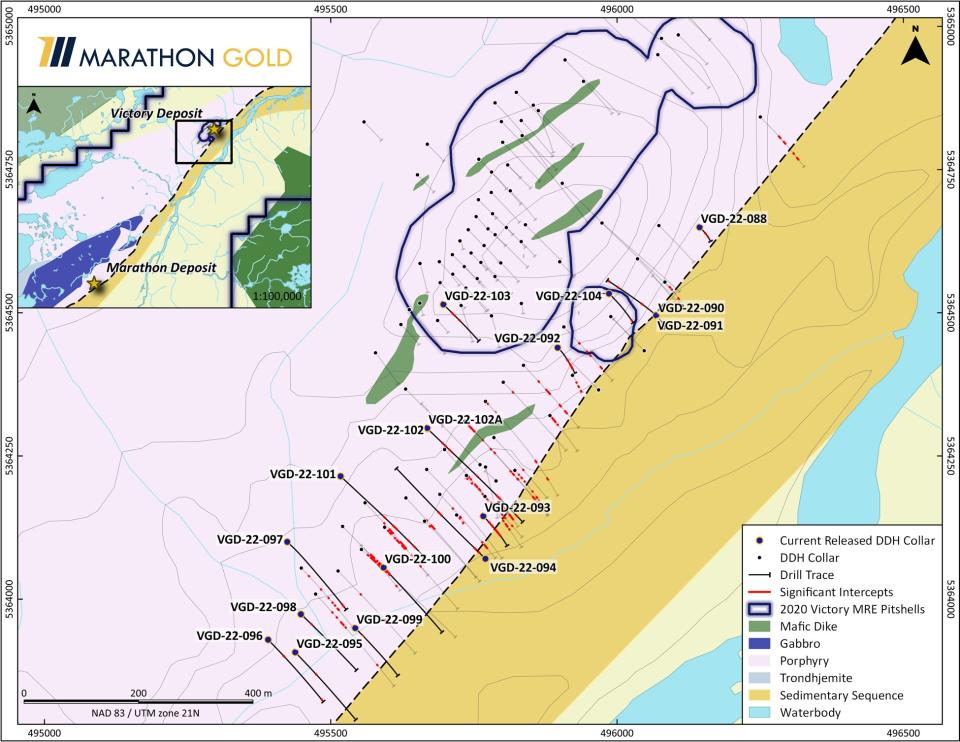
Figure 6: Long Section of the Victory Deposit (View NW) Incorporating all Drilling up to VGD-22-104, representing 19,290 metres, and Assays Above 0.3 g/t Au (top) and 0.1 g/t Au (bottom). Drill holes reported in today’s release are indicated with blue traces.

Frank Zone
The Marathon exploration team is excited to turn attention back to the Frank Zone, located one kilometre southwest of the Leprechaun Deposit. The Frank Zone is characterized by large and laterally continuous quartz veins which are visible at surface from the air. Frank was previously trenched and drilled between 2011 and 2012. Work was deprioritised upon the receipt of initial drill results at the Leprechaun Deposit, and then again by the discovery of the Marathon and Berry Deposits. No work has been conducted since 2012, and it does not feature in the current 3-pit mine plan.
An early geological interpretation of Frank was that it represented a distinct and potentially younger mineralizing event to the main gold mineralization at Valentine and, as such, merited less exploration. A recent review of trenching and drill-hole data using advanced geological modeling tools, newly collected Televiewer structural measurement data, and the benefit of a more complete understanding of the controls on gold mineralization at Valentine has determined that Frank represents yet another instance of stacked QTP-Au vein mineralization in the familiar Valentine style.
Figure 7 presents an updated geological model for Frank compared to the nearby Leprechaun and Berry Deposits, with a QTP mineralized domain (yellow) enclosing southwest dipping QTP-Au veins, mafic dykes (green) serving to localize brittle deformation and vein emplacement and the proximal Rogerson Lake conglomerate (brown) in contact at the VLSZ. This comparison illustrates the minimal amount of diamond drilling conducted to date at Frank compared to Leprechaun and Berry, and each system’s relative scale.
Figure 7: Side by Side geological models, with drilling, for the Frank Zone (top), The Leprechaun Deposit (middle) and the Berry Deposit (bottom). Same scale. Geological domains are footwall sediments (brown), QTPV mineralized domain (yellow), mafic dykes (green). View to SW.
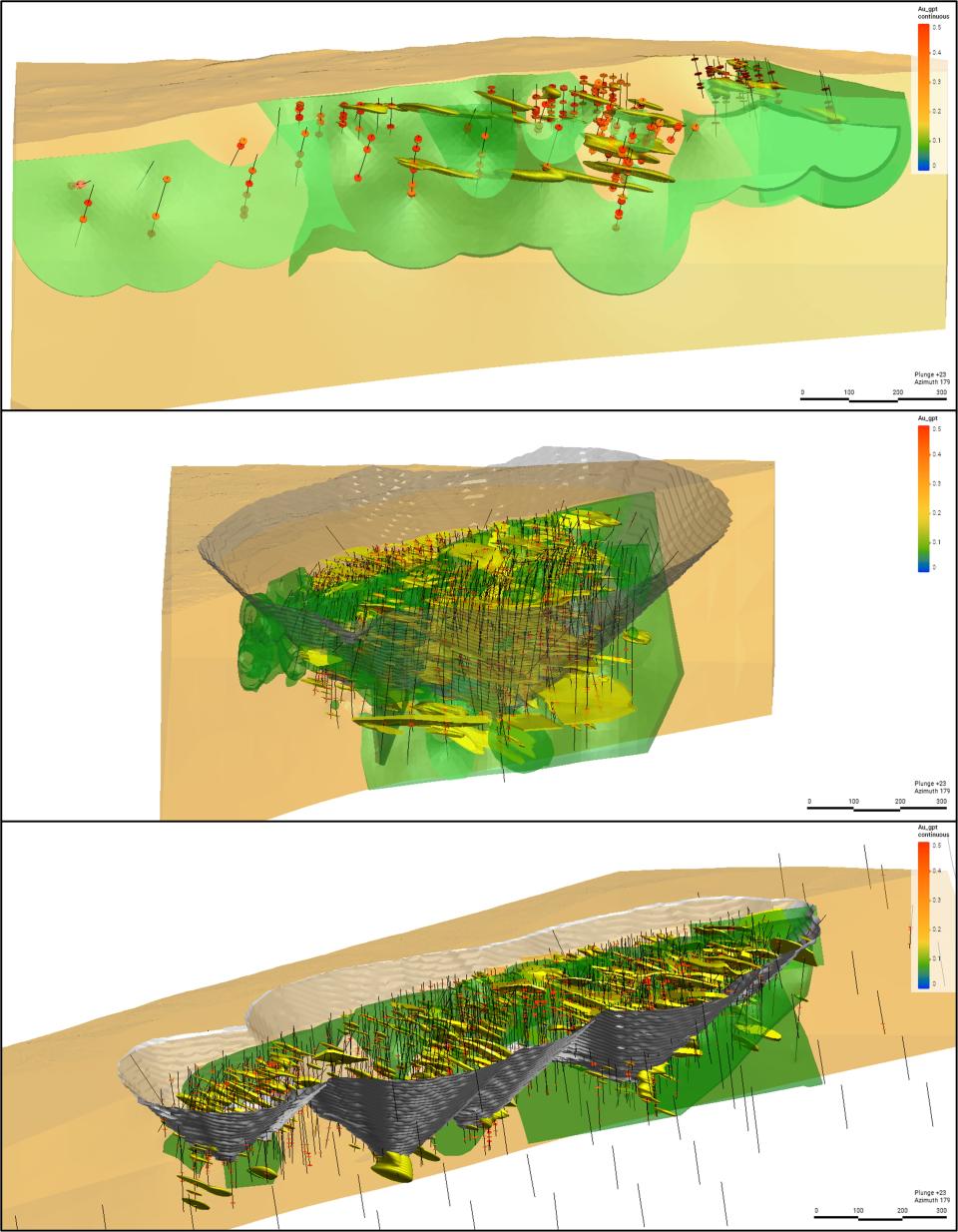
Assay data from the 2011 and 2012 Frank Zone drilling are being re-released today using the same conventions for drill-hole intercepts established by Marathon in its current exploration. The drilling was conducted before the current Valentine deposit model of generally SW-dipping, stacked QTP-Au veins within densified “Main Zone” configurations was established. Because of this, the majority of the 66 drill holes at Frank were oriented at relatively shallow inclinations to the southeast, designed to intersect the Rogerson Lake Conglomerate at the VLSZ contact. This caused most holes to be drilled at a relatively low angle of incidence to the dominant structural style of mineralization. Nonetheless, all of the drill holes were located within hanging-wall Precambrian granitoid rocks, and forty-three returned “significant” drill intercepts of greater than 0.7 g/t Au (Table 2). An additional eleven drill-holes returned intercepts above 0.30 g/t Au, the bottom cut-off used in the July 2022 Valentine Mineral Resource Estimate.
Access to the Frank Zone is excellent, and the historical trenches remain open. Additional diamond drilling is merited, including at the steep NW orientation which provides the best indication of the Main Zone-type gold mineralization seen at the other Valentine mineral deposits. If successful, the Frank Zone offers the potential for additional open-pit mineral resources within convenient trucking distance of the Valentine mill.
2023 Exploration Planning
The 2023 exploration program will focus on further developing the grassroots targets initially defined during the 2022 season. The Eastern Arm will see an extensive trenching program targeting the contact between the Rogerson Lake Conglomerate and the granitoid rocks to the north, along with additional prospecting and follow-up on till sample results. Further exploration will be undertaken on the Western Peninsula. Following the prospecting and trenching programs, a fall drill program is planned to further define mineralization in the Frank Zone. Exploration permits for the 2023 drilling and trenching have been received, with amendments to allow the development of access trails in the Eastern Arm under review.
Table 1: Significant Assay Intervals from Drill Hole Collars Reported, Victory Deposit, Valentine Gold Project
DDH | Section | Az | Dip | From | To | Core | True | Gold | Gold |
VGD-22-088 | 21810E | 135 | -80 | 78 | 80 | 2 | 1.80 | 0.90 |
|
|
|
|
| 116 | 117 | 1 | 0.90 | 0.97 |
|
VGD-22-091 | 21690E | 312 | -75 | 102 | 104 | 2 | 1.88 | 1.21 |
|
|
|
|
| 228 | 230 | 2 | 1.88 | 0.76 |
|
|
|
|
| 270 | 271 | 1 | 0.94 | 1.71 |
|
VGD-22-092 | 21510E | 312 | -75 | 194 | 195 | 1 | 0.94 | 0.95 |
|
|
|
|
| 205 | 206 | 1 | 0.94 | 14.86 |
|
|
|
|
| 261 | 263 | 2 | 1.88 | 3.22 |
|
|
|
|
| 267 | 268 | 1 | 0.94 | 0.72 |
|
|
|
|
| 281 | 282 | 1 | 0.94 | 0.76 |
|
|
|
|
| 297 | 298 | 1 | 0.94 | 0.90 |
|
|
|
|
| 301 | 303 | 2 | 1.88 | 0.79 |
|
|
|
|
| 311 | 312 | 1 | 0.94 | 0.92 |
|
VGD-22-093 | 21300E | 136 | -78 | 72 | 77 | 5 | 4.44 | 1.01 |
|
|
|
|
| 104 | 105 | 1 | 0.89 | 0.71 |
|
|
|
|
| 107 | 108 | 1 | 0.89 | 1.04 |
|
|
|
|
| 115 | 116 | 1 | 0.89 | 1.04 |
|
|
|
|
| 148 | 149 | 1 | 0.89 | 1.34 |
|
|
|
|
| 154 | 157 | 3 | 2.66 | 3.21 |
|
|
|
|
| 161 | 162 | 1 | 0.89 | 0.72 |
|
|
|
|
| 173 | 174 | 1 | 0.89 | 3.30 |
|
|
|
|
| 178 | 179 | 1 | 0.89 | 1.11 |
|
|
|
|
| 198 | 199 | 1 | 0.89 | 1.51 |
|
|
|
|
| 204 | 205 | 1 | 0.89 | 0.79 |
|
VGD-22-094 | 21280E | 315 | -44 | 21 | 23 | 2 | 1.51 | 4.06 |
|
|
|
|
| 32 | 36 | 4 | 3.03 | 1.07 |
|
|
|
|
| 141 | 142 | 1 | 0.76 | 1.85 |
|
|
|
|
| 148 | 150 | 2 | 1.51 | 1.05 |
|
VGD-22-095 | 20920E | 136 | -58 | 97 | 98 | 1 | 0.72 | 1.57 |
|
VGD-22-096 | 20880E | 135 | -65 | 90 | 94 | 4 | 3.16 | 1.06 |
|
|
|
|
| 299 | 300 | 1 | 0.79 | 1.57 |
|
VGD-22-097 | 20960E | 132 | -64 | 292 | 294 | 2 | 1.58 | 0.72 |
|
|
|
|
| 300 | 301 | 1 | 0.79 | 3.32 |
|
VGD-22-098 | 20950E | 132 | -65 | 4.37 | 14 | 9.63 | 7.68 | 3.50 |
|
Including |
|
|
| 11 | 12 | 1 | 0.80 | 25.53 |
|
|
|
|
| 59 | 60 | 1 | 0.80 | 0.70 |
|
VGD-22-099 | 21030E | 134 | -68 | 51 | 52 | 1 | 0.82 | 0.91 |
|
VGD-22-100 | 21110E | 136 | -48 | 8 | 21 | 13 | 7.77 | 0.93 |
|
VGD-22-101 | 21080E | 134 | -57 | 176 | 180 | 4 | 2.85 | 0.81 |
|
|
|
|
| 211 | 226 | 15 | 10.68 | 2.11 |
|
Including |
|
|
| 215 | 216 | 1 | 0.71 | 12.16 |
|
|
|
|
| 270 | 272 | 2 | 1.42 | 0.96 |
|
|
|
|
| 291 | 297 | 6 | 4.27 | 0.82 |
|
VGD-22-102 | 21250E | 134 | -57 | 66 | 67 | 1 | 0.71 | 1.94 |
|
|
|
|
| 79 | 81 | 2 | 1.42 | 1.32 |
|
|
|
|
| 96 | 97 | 1 | 0.71 | 0.81 |
|
|
|
|
| 106 | 107 | 1 | 0.71 | 1.78 |
|
|
|
|
| 208 | 209 | 1 | 0.71 | 5.01 |
|
|
|
|
| 284 | 287 | 3 | 2.14 | 0.77 |
|
|
|
|
| 292 | 301 | 9 | 6.41 | 1.05 |
|
|
|
|
| 361 | 362 | 1 | 0.71 | 2.53 |
|
VGD-22-103 | 21340E | 134 | -70 | 58 | 63 | 5 | 4.18 | 1.30 |
|
|
|
|
| 80 | 81 | 1 | 0.84 | 0.91 |
|
|
|
|
| 115 | 116 | 1 | 0.84 | 6.86 |
|
VGD-22-104 | 21620E | 134 | -77 | 256 | 259 | 3 | 2.65 | 0.85 |
|
Notes on the Calculation of Assay Intervals
“Significant” assay intervals are defined as 1m core length or more of mineralization with an average fire assay result of greater than 0.7 g/t Au, representing the bottom cut-off for high-grade mill feed in the Marathon December 2022 Updated Feasibility Study mine plan. Assay intervals with an average fire assay result of between 0.3 g/t Au and 0.7 g/t Au are above the cut-off used in the July 2022 Mineral Resource estimate for the Berry Deposit but are not considered “significant” for the purposes of this news release.
Cut gold grades are calculated at 30 g/t Au.
True thickness was calculated using the orientation of the drill hole at the collar and an average dip and dip direction of mineralization of 20⁰/200⁰.
No significant results in drill holes VGD-22-090, 102A and 104A
Table 2: Significant Assay Intervals from Drill Hole Collars VL-11-366 to VL-11-501, Frank Zone, Valentine Gold Project
DDH | Section | Az | Dip | From | To | Core | True | Gold | Gold |
VL-11-366 | 8900E | 163 | -82 | 19 | 24 | 5 | 4.51 | 3.49 |
|
|
|
|
| 69 | 70 | 1 | 0.90 | 2.00 |
|
VL-11-368 | 8960E | 163 | -50 | 7 | 8 | 1 | 0.59 | 0.84 |
|
|
|
|
| 13 | 14 | 1 | 0.59 | 0.72 |
|
VL-11-369 | 8960E | 165 | -76 | 5 | 6 | 1 | 0.86 | 1.35 |
|
|
|
|
| 13 | 14 | 1 | 0.86 | 0.75 |
|
|
|
|
| 20 | 21 | 1 | 0.86 | 0.85 |
|
VL-11-370 | 9050E | 163 | -76 | 76 | 77 | 1 | 0.86 | 1.08 |
|
VL-11-371 | 9100E | 166 | -76 | 12 | 13 | 1 | 0.86 | 0.88 |
|
|
|
|
| 38 | 39 | 1 | 0.86 | 0.94 |
|
VL-11-374 | 9000E | 165 | -75 | 2.36 | 6 | 3.64 | 3.12 | 1.07 |
|
|
|
|
| 37 | 38 | 1 | 0.86 | 2.09 |
|
|
|
|
| 50 | 51 | 1 | 0.86 | 1.05 |
|
|
|
|
| 55 | 56 | 1 | 0.86 | 3.02 |
|
VL-11-375 | 8475E | 164 | -78 | 42 | 44 | 2 | 1.76 | 0.68 |
|
|
|
|
| 51 | 53 | 2 | 1.76 | 0.71 |
|
|
|
|
| 73 | 74 | 1 | 0.88 | 2.69 |
|
VL-11-376 | 8475E | 164 | -52 | 22 | 23 | 1 | 0.62 | 10.23 |
|
|
|
|
| 34 | 35 | 1 | 0.62 | 1.08 |
|
|
|
|
| 40 | 41 | 1 | 0.62 | 0.96 |
|
|
|
|
| 100 | 102 | 2 | 1.35 | 0.90 |
|
VL-12-422 | 9125E | 163 | -56 | 80 | 81 | 1 | 0.60 | 0.75 |
|
VL-12-423 | 8750E | 162 | -50 | 80 | 81 | 1 | 0.60 | 0.75 |
|
|
|
|
| 95 | 96 | 1 | 0.60 | 0.88 |
|
VL-12-424 | 9600E | 163 | -29 | 72 | 73 | 1 | 0.29 | 1.60 |
|
|
|
|
| 81 | 84 | 3 | 0.87 | 1.29 |
|
|
|
|
| 88 | 90 | 2 | 0.58 | 1.20 |
|
|
|
|
| 106 | 107 | 1 | 0.29 | 0.74 |
|
VL-12-425 | 9300E | 161 | -55 | 112 | 113 | 1 | 0.67 | 1.51 |
|
|
|
|
| 157 | 158 | 1 | 0.67 | 0.88 |
|
|
|
|
| 218 | 219 | 1 | 0.67 | 1.31 |
|
|
|
|
| 223 | 224 | 1 | 0.67 | 0.80 |
|
|
|
|
| 246 | 249 | 3 | 2.01 | 0.70 |
|
VL-12-426 | 8750E | 165 | -58 | 161 | 162 | 1 | 0.70 | 1.02 |
|
|
|
|
| 168 | 173 | 5 | 3.48 | 1.39 |
|
VL-12-427 | 9600E | 163 | -54 | 71 | 72 | 1 | 0.65 | 0.78 |
|
VL-12-428 | 9000E | 163 | -51 | 14 | 15 | 1 | 0.61 | 20.08 |
|
|
|
|
| 224 | 225 | 1 | 0.61 | 0.71 |
|
VL-12-429 | 8600E | 162 | -55 | 91 | 97 | 6 | 4.00 | 1.31 |
|
VL-12-431 | 8475E | 164 | -54 | 86 | 87 | 1 | 0.64 | 1.10 |
|
|
|
|
| 92 | 94 | 2 | 1.28 | 3.97 |
|
|
|
|
| 105 | 107 | 2 | 1.28 | 0.99 |
|
|
|
|
| 110 | 111 | 1 | 0.64 | 1.84 |
|
|
|
|
| 118 | 119 | 1 | 0.64 | 0.97 |
|
|
|
|
| 123 | 126 | 3 | 1.93 | 1.14 |
|
|
|
|
| 141 | 142 | 1 | 0.64 | 3.45 |
|
|
|
|
| 149 | 157 | 8 | 5.14 | 0.96 |
|
VL-12-432 | 9450E | 163 | -55 | 249 | 251 | 2 | 1.32 | 1.97 |
|
VL-12-433 | 8900E | 163 | -60 | 45 | 47 | 2 | 1.45 | 4.01 |
|
|
|
|
| 99 | 100 | 1 | 0.72 | 0.74 |
|
|
|
|
| 213 | 214 | 1 | 0.72 |

 Yahoo Finance
Yahoo Finance 